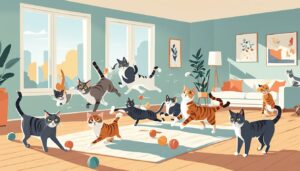Cats hold a special place in the hearts of children, captivating their imaginations and fostering unique bonds. There are numerous benefits to children owning cats, from fostering empathy and teaching responsibility to providing emotional support and boosting self-esteem.
So, why are kids drawn to cats? It’s no secret that children are fascinated by these mysterious and playful creatures. Cats provide companionship, entertainment, and a sense of comfort, which children find irresistible. The positive impact of cats on kids’ lives is undeniable, offering not only joy and companionship but also developmental benefits.
Through the companionship of cats, children learn valuable life lessons. Taking care of a cat teaches responsibility, as kids become responsible for feeding, grooming, and ensuring their feline friend’s overall well-being. Cats also help children develop empathy and emotional understanding, as they learn to interpret non-verbal cues and establish strong emotional bonds.
Furthermore, cats can contribute to children’s social skills development. By interacting with their feline companions, kids learn important communication skills, such as understanding the needs of others and recognizing non-verbal cues. The bond formed with a cat can encourage healthy social interaction, boosting overall social skills.
In addition, research has shown that cats can have a positive impact on kids’ immune system health. Having a cat in the house during a baby’s first year of life can help improve the infant’s immune system, reducing respiratory infections and colds.
Choosing the right cat for children is crucial. Some cat breeds are known for their calm and gentle nature, making them ideal companions for kids. Factors such as temperament and compatibility with children should be considered when selecting a cat.
Overall, the reasons why children love cats are endless. From the sense of companionship and happiness they bring to the valuable life lessons they teach, cats have a remarkable impact on children’s lives.
Key Takeaways:
- Cats offer numerous benefits to children, including fostering empathy and teaching responsibility.
- Children are drawn to cats due to their companionship, entertainment, and comfort.
- Cats contribute to children’s social skills development and can have a positive impact on their immune system health.
- Choosing the right cat for children is important, considering factors such as temperament and compatibility.
- The bond between children and cats offers endless joy and brings valuable life lessons.
Pets that teach children valuable lessons
Cats make wonderful pets for kids, offering more than just companionship and entertainment. They also provide valuable life lessons that can shape a child’s character and development.
Fostering empathy through cat companionship
When children own cats, they learn to be compassionate and considerate towards their feline friends. Interacting with cats teaches kids the importance of understanding and empathizing with others, even those who may communicate differently.
“Having a cat has taught my child to be kind and gentle. They’ve learned to recognize the moods and needs of our cat and respond with empathy.”
By observing the subtle cues and body language of cats, children develop a deeper sense of empathy and emotional intelligence. They learn to respond to their furry companions’ needs and provide them with love and care.
Teaching responsibility through cat ownership
Cat ownership comes with a set of responsibilities, and when children are involved in caring for their feline friends, they learn valuable life skills.
Feeding, grooming, and cleaning the litter box are tasks that teach children the importance of being responsible and reliable. This ownership experience instills a sense of pride and accomplishment in kids, boosting their self-esteem.
“Taking care of our cat has taught my child the value of routine and commitment. They understand the importance of providing for someone else’s well-being.”
Through cat ownership, children learn the significance of fulfilling obligations and following a routine. They understand that their actions directly impact the well-being of their furry companion.
Developmental benefits of children’s relationships with cats
The bond between a child and their cat can have a profound impact on a child’s development. It promotes social, emotional, and cognitive growth.
- Cognitive development: Interacting with a cat helps children improve their cognitive abilities, such as problem-solving and decision-making. They learn to navigate the cat’s behavior, anticipate their needs, and adjust their actions accordingly.
- Social development: Owning a cat encourages healthy social interaction. Children learn to communicate non-verbally with their feline friends, understanding their cues and signals.
- Emotional development: Cats provide comfort and emotional support to children. The bond between a child and their cat offers a safe space to express emotions, build confidence, and develop a sense of security.
The developmental benefits of children’s relationships with cats are undeniable. Owning a cat can contribute to a child’s overall well-being and personal growth.
Building patience through cat companionship
Cats have a unique way of teaching children the value of patience and understanding. As kids form a bond with their feline companions, they quickly realize the importance of taking things slowly and being gentle with their furry friends.
The process of building a connection with a cat requires patience and empathy, which are essential skills for children to develop. Cats have their own personalities and preferences, and children learn to respect and accommodate these individual traits.
By observing and understanding a cat’s behavior, children become attuned to non-verbal cues and learn to interpret the needs and emotions of their feline friends. This ability to read and respond to subtle signals fosters empathy and enhances their interpersonal skills.
“Having a cat requires a level of patience and understanding. Cats aren’t always interested in play and attention, and they appreciate when children respect their boundaries. This teaches kids to be patient and considerate, skills that extend beyond their interactions with pets.”
Through daily interactions with cats, children learn that patience and consistency are key to establishing trust and building a strong bond. They understand that cats may take time to warm up, and they experience the joy of earning a cat’s affection through their patient efforts.
Fostering empathy and emotional growth
The patience required in cat companionship extends beyond the physical realm. Cats offer emotional support, and children learn to provide comfort and care during difficult times. Through their bond with a cat, kids develop a deeper empathy, understanding the importance of being there for others in times of need.
As children navigate their emotions alongside their feline companions, they learn the value of emotional well-being and the power of unconditional love. Cats provide a safe space for kids to express their feelings, offering nonjudgmental companionship and becoming a source of comfort and solace.
Furthermore, children learn the positive impact their actions have on others’ emotions through their interactions with cats. They understand that being gentle and kind can brighten a cat’s day, reinforcing the importance of empathy and compassion in their overall relationships.
Developing valuable life skills
The patience cultivated through cat companionship translates into various aspects of a child’s life. Kids learn that not everything happens instantly and that some things require time and effort. They develop the ability to persevere through challenges and setbacks, understanding that progress often occurs gradually.
Caring for a cat also nurtures a sense of responsibility in children. From feeding and grooming to ensuring their well-being, kids learn the importance of fulfilling obligations and attending to the needs of others. These responsibilities contribute to their personal growth and self-confidence, providing them with a sense of purpose and accomplishment.
The patience acquired through cat companionship serves as a foundation for other life skills, promoting resilience, adaptability, and a mindset of continuous growth.
Cats as Great Companions for Kids
Cats are truly remarkable companions for children. They form a unique bond with kids and bring an array of benefits to their lives. Whether it’s providing comfort, engaging in playfulness, or offering unwavering friendship, cats have a special way of captivating young hearts.
One of the reasons kids are drawn to cats is their innate ability to connect with children on a deep level. Cats are often intrigued by the energy and curiosity exuded by kids, creating an instant connection between the two. This bond brings immense joy, happiness, and a sense of companionship to both the child and the cat.
Having a cat as a companion can have numerous positive impacts on a child’s emotional well-being. Cats can be a source of comfort and support during difficult times, helping children navigate their emotions and develop a sense of empathy. The non-verbal communication between cats and kids teaches children to interpret and understand emotions, strengthening their emotional intelligence and fostering empathy.
Additionally, cats provide endless entertainment and playfulness, which is highly appealing to children. Kittens and cats engage in interactive play, encouraging kids to be active and creative. This playful interaction not only brings joy but also helps in developing motor skills, coordination, and cognitive abilities in children.
I believe that cats have a unique way of bringing comfort and joy to children. Their presence creates a special bond that is irreplaceable. Seeing my daughter’s face light up when she interacts with her cat is priceless. They truly are the best companions for kids!
Introducing a cat into a child’s life can also teach responsibility. Children learn to care for their feline friends by feeding them, cleaning their litter boxes, and providing them with love and attention. This responsibility fosters a sense of ownership and accomplishment in children, boosting their self-esteem and sense of pride.
Overall, cats make exceptional companions for kids due to their ability to bond with children, their playful nature, and the emotional and developmental benefits they offer. The presence of a cat in a child’s life can bring endless joy, teach valuable life lessons, and create memories that will be cherished for a lifetime.
Benefits of Cats as Companions for Kids
| Benefits | Description |
|---|---|
| Emotional Support | Cats provide comfort and support during challenging moments, fostering empathy and emotional understanding in children. |
| Playfulness | Kittens and cats engage in interactive play, encouraging children to be active and creative while improving motor skills and cognitive abilities. |
| Responsibility | Caring for a cat teaches children the importance of responsibility and ownership, boosting their self-esteem and sense of accomplishment. |
| Unique Bond | Cats form a special connection with children, drawn to their energy and curiosity, creating a deep bond of companionship. |
Cats and Immune System Health
Research has revealed the positive impact cats can have on the health of children, particularly their immune system. Having a cat in the house during a baby’s first year of life has been shown to improve the infant’s immune system function.
Cats contribute to a healthier environment by reducing the occurrence of respiratory infections and colds in children. This is particularly beneficial for young kids, who are more susceptible to these types of illnesses.
| Benefits of Cats on Kids’ Immune System |
|---|
| Cats help build a stronger immune system |
| Cats decrease the risk of allergies and asthma |
| Cats promote a healthier indoor environment |
| Cats reduce the occurrence of respiratory infections and colds |
When children are exposed to cats from a young age, their bodies develop a better ability to combat common illnesses and allergies. Research suggests that this exposure helps train their immune system to respond effectively to various pathogens.
This positive impact on kids’ health makes cats even more appealing to young ones. Children’s fascination with cats extends beyond their playfulness and companionship to their potential health benefits. By having a cat as a furry friend, children not only gain a loyal companion but also strengthen their immune system naturally.
Emotional Benefits of Cat Ownership
Owning a cat has numerous emotional benefits for children. Cats offer a unique companionship that can provide comfort and support during difficult times, helping children navigate their emotions with ease. The bond formed between children and their feline friends can foster empathy and emotional understanding, as they learn to interpret non-verbal communication and develop stronger emotional connections.
When a child cuddles up with a cat, it creates a sense of security and warmth that can reduce stress and anxiety. Cats are excellent listeners and can provide a safe space for children to express their feelings without fear of judgment or criticism. This emotional support promotes a healthy emotional well-being and helps children develop a positive outlook on life.
“Having a cat has taught my child how to be sensitive to others’ needs and emotions. They’ve developed a genuine sense of empathy and a deep understanding of non-verbal communication. It’s heartwarming to see the emotional growth and connection they have with their cat.” – Sarah, proud parent
Through the companionship of a cat, children also learn to be more compassionate and caring. They develop a sense of responsibility towards their furry friend, taking care of their needs and ensuring their well-being. This sense of responsibility fosters empathy and nurtures a child’s ability to understand and meet the emotional needs of others.
The emotional benefits of cat ownership extend beyond the immediate bond between a child and their pet. Children who grow up with cats often develop better emotional regulation and stress management skills. The presence of a cat can help children feel calmer and more at ease, reducing feelings of loneliness and providing a source of comfort and companionship.
Developing Emotional Bonds through Cats
Cats have a unique way of silently communicating with their owners. They rely on non-verbal cues such as body language, facial expressions, and purring to express their emotions. Children who own cats develop an understanding of these non-verbal cues, enhancing their ability to read emotions in both cats and humans.
This enhanced emotional intelligence allows children to develop stronger emotional bonds with their family, friends, and even future pets. They learn to recognize and respond to the emotional needs of others, fostering deeper connections and more meaningful relationships.
The Power of Cat Companionship
The companionship of a cat can have a profound impact on a child’s emotional well-being. From providing comfort during difficult times to fostering empathy and emotional understanding, cats play a vital role in nurturing a child’s emotional development.
So the next time you see a child with their beloved feline friend, remember that their bond extends far beyond cuddles and playtime. It’s a bond that nurtures empathy, strengthens emotional connections, and shapes the child into a more compassionate and caring individual.
Social Skills Development through Cat Ownership
When it comes to nurturing social skills in children, the benefits of owning a cat are undeniable. Interacting with their feline companions provides kids with valuable opportunities to develop vital communication skills, understand non-verbal cues, and empathize with the needs of others. The bond formed between children and their cats encourages healthy social interaction, fostering the growth of essential social skills.
Through playful interactions and daily care routines, children learn to interpret their cat’s behavior and respond accordingly. This enhances their ability to recognize and understand non-verbal cues, an essential skill that translates into better communication with others in various social settings. The ability to read and respond to facial expressions, body language, and moods lay the foundation for successful interpersonal relationships.
Furthermore, the responsibility that comes with cat ownership teaches children empathy and consideration for others. Caring for their furry companion requires understanding and tending to their needs, fostering empathy through companionship. Kids learn to anticipate their cat’s desires and ensure their well-being, contributing to their overall development of empathy towards animals and humans alike.
“Having a cat enables children to develop interpersonal skills, such as non-verbal communication and empathy, which can significantly impact their social interactions and relationships.”
Research has also demonstrated that children who have positive relationships with pets, such as cats, show improved social competence, self-esteem, and overall psychological well-being. Cats provide a non-judgmental presence that can ease anxiety and promote a sense of comfort, acting as a reliable companion during challenging times.
Here’s a table highlighting some of the developmental benefits that children can gain through their relationships with cats:
| Developmental Benefits of Children’s Relationships with Cats |
|---|
| Fosters empathy and understanding |
| Enhances communication and non-verbal skills |
| Promotes social interaction and cooperation |
| Builds self-esteem and emotional resilience |
| Provides companionship and comfort during difficult times |
By owning a cat, children not only benefit from the joys of companionship but also develop invaluable social skills that will positively influence their interactions with others throughout their lives.

Boosting Self-Esteem through Cat Care
As a parent, you want to see your child grow and thrive with confidence. One way to foster self-esteem in children is through the care and responsibility of owning a cat. When children take on the tasks of feeding, grooming, and caring for their feline friend, they develop a sense of importance and accomplishment.
The act of caring for a living creature teaches children the value of responsibility. It helps them understand that their actions have a direct impact on another being’s well-being. By taking charge of their cat’s daily needs, children learn to prioritize and manage tasks effectively.
This sense of responsibility not only builds character but also contributes to their overall self-worth and confidence. As children successfully fulfill their role as a cat owner, they develop a sense of pride and achievement, which positively influences their self-esteem.
The bond between children and their cats further strengthens their emotional well-being. Cats offer unconditional love, comfort, and support, acting as constant companions during challenging times. Sharing this special bond with a cat enhances children’s emotional intelligence, allowing them to navigate their emotions and develop empathy.
Through cat care, children learn to interpret their feline companion’s non-verbal cues, such as tail flicks and body language. This skill fosters their ability to understand the needs of others and respond empathetically, promoting healthier relationships and enhancing their social skills.
In addition, taking care of a cat provides opportunities for children to problem-solve and make decisions. They learn to anticipate their pet’s needs, assess potential risks, and find creative solutions. These problem-solving skills profoundly impact a child’s self-confidence, empowering them to tackle challenges with resilience and resourcefulness.
Overall, the responsibility of cat ownership offers numerous developmental benefits for children. It not only teaches them the importance of caring for another living being but also nurtures their self-esteem, emotional intelligence, and problem-solving skills. By taking care of a cat, children gain a sense of purpose and accomplishment, while also forming a lifelong bond with a furry friend.
Key Benefits:
- Develops a sense of responsibility and accomplishment
- Fosters empathy and emotional understanding
- Enhances problem-solving and decision-making skills
- Builds self-confidence and self-esteem
- Promotes healthy social and emotional development
Choosing the Right Cat for Children
When it comes to getting a cat for your children, it’s important to consider their needs and preferences. Certain cat breeds are known for their calm and gentle nature, making them ideal companions for kids. By selecting the right cat, you can ensure a strong bond and a positive experience for both the children and the feline friend.
Temperament and Compatibility
One of the crucial factors to consider when choosing a cat for children is their temperament. Some breeds, such as the Ragdoll or the Maine Coon, are known for their friendly and patient nature, making them great choices for households with kids. These cats are typically tolerant of children’s playful behavior and enjoy affectionate interactions.
It’s also essential to consider compatibility between the cat and the children. Each cat has its own personality, just like children do. Some cats may be more introverted and independent, while others may be more playful and sociable. Assessing the children’s energy levels, activity preferences, and their ability to handle a cat’s needs can help in finding a cat that matches their lifestyle.
Introductory Period and Socialization
When bringing a new cat into a household with children, it’s important to give them a proper introduction. Allow the cat to familiarize themselves with their new environment and let the children gradually approach and interact with the cat under adult supervision. This helps in establishing trust and ensuring a positive start to their relationship.
Socialization is important for both children and cats. Encourage children to spend quality time with the cat, engaging in gentle play and providing affection. This helps in building a strong bond and fosters mutual understanding between them.
Considerations for Allergies
If any family members have allergies, it’s crucial to choose a cat breed that is hypoallergenic or produces fewer allergens. Some breeds, like the Siberian or the Balinese, are known to be more suitable for individuals with allergies. However, it’s important to remember that individual reactions can still vary, and it’s best to consult with a healthcare professional regarding any concerns.
The Right Cat for Lifelong Companionship
The decision to bring a cat into your home is one that should be made with careful thought and consideration. By selecting a cat with the right temperament, compatibility, and considering any allergies, you can ensure a lifelong companionship that brings joy, love, and countless memorable moments for your children.

Teaching Appropriate Behavior with Cats
Teaching responsibility through cat ownership
As parents, it is our responsibility to teach our children how to properly interact and care for their feline companions. By modeling appropriate behavior, we can ensure a healthy bond between our children and their beloved pets.
Modeling Respectful and Responsible Behavior
Children learn by observing and imitating their parents’ actions. Therefore, it is essential that we demonstrate respectful and responsible behavior towards cats. Here are a few ways we can do this:
- Handling: Show your child how to handle a cat gently. Teach them to approach slowly, avoiding sudden movements or loud noises that may startle the cat. Emphasize the importance of petting and stroking the cat in the direction of its fur.
- Feeding: Involve your child in the feeding process. Teach them about portion control and the importance of a balanced diet for their cat’s health. Explain that treats should be given sparingly and as a form of reward.
- Playtime: Teach your child how to engage in interactive play with their cat using appropriate toys. Encourage gentle play and discourage any rough behaviors that may harm the cat.
By modeling these behaviors, we can help children develop a respectful and responsible attitude towards their feline companions, while fostering a loving and nurturing environment for both the child and the cat.
“Children learn to be responsible pet owners by watching and imitating their parents’ behavior. By teaching our children how to properly care for and interact with cats, we can instill important values of compassion and empathy.”
– Dr. Sarah Mitchell, Veterinarian
Remember, establishing a positive and respectful relationship with a cat takes time and patience. Encourage your child to be gentle, kind, and considerate towards their feline friend. This not only teaches responsibility but also promotes empathy and understanding, valuable life skills that will benefit your child beyond cat ownership.
Next, we will explore the importance of cat ownership for toddlers and how to ensure a safe and harmonious relationship between them and their feline companions.
Cats and Toddlers
Cats can make wonderful pets for toddlers, providing them with a source of fascination and companionship. However, it is important for parents to be aware that having a cat around young children requires extra supervision and intervention.
Toddlers are often drawn to cats because of their adorable and playful nature. They are captivated by the way cats move and interact with the world around them. This fascination can provide endless entertainment for little ones.
However, it’s crucial to remember that toddlers may lack impulse control and understanding of boundaries. They may not fully grasp that cats have their own limits and may need personal space. As a result, parents must facilitate introductions between cats and toddlers in a careful and controlled manner.
Parents should always prioritize the safety and well-being of both the child and the cat. It is recommended to teach toddlers how to interact with cats gently and respectfully. This can include teaching them to stroke gently, avoid pulling the cat’s tail or ears, and not to disturb the cat while it is eating or sleeping. Regular monitoring and supervision are essential to prevent any accidental harm to either the child or the cat.







